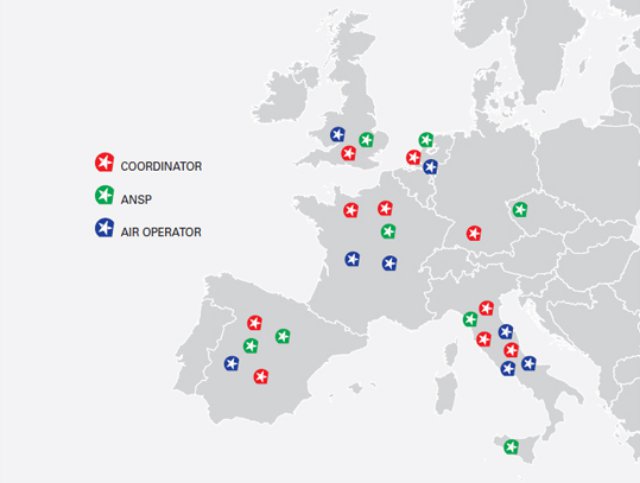The SESAR Joint Undertaking has just announced the demonstration projects selected for funding as a result of a call launched in February 2013 for proposals in order to select and co-finance a series of projects offering SESAR integrated RPAS demonstration activities. The purpose of this call was to select a number of projects or activities, including integrated pre-operational flight trials activities, which aim to:
- Demonstrate how to integrate RPAS into nonsegregated airspace in a multi-aircraft flight environment, with the purpose of exploring the feasibility of integration within the wider aviation community by 2016;
- Focus on concrete results filling the operational and technical gaps identified for RPAS integration into non-segregated airspace; and
- Capitalise on the SESAR delivery approach by providing synergies, risk and opportunities, with the overall SESAR programme.
As a result of the call, 9 out of 23 RPAS Demonstration Projects were selected, with a co-financing of EUR 4 million. The selected Demonstration Projects represent 38 different partners from 8 different countries: Czech Republic, France, Germany, Italy, Malta, The Netherlands, Spain and United Kingdom. Each project includes an ANSP and Air Operators and will be carried out within the European Union and/or within EUROCONTROL’s member states.
The Demonstration Projects will incorporate existing SESAR R&D and will also cover some of SESAR’s focus areas, such as Airborne Spacing and Separation, Integrated Controller Working Position, Surface Planning and Routing, and Business and Mission Trajectory. Both optionally piloted and completely remotely piloted systems will be participating in the demo activities. Various types and sizes of RPAS, such as rotary wing, motor gliders, and light observation aircraft both civil and military, will be involved in the Demonstration Projects, which are expected to take place between the third quarter of 2013 and first quarter of 2015.
The full transparent integration of RPAS into nonsegregated airspace will not happen overnight. The SESAR programme, along with its partners, hopes that this new wave of demonstration activities will be a first step towards achieving this pioneering goal.
The European Remotely Piloted Air Systems Steering Group (ERSG), established by the European Commission in 2012, has recognised a need to identify, plan, coordinate, and subsequently monitor the activities necessary to achieve the safe integration of RPAS into a non-segregated ATM environment. Given that the full integration of RPAS into the European ATM System is vital and that the mission of SESAR is to create the new generation of ATM systems and operations, RPAS will need to be incorporated into future SESAR solutions.
RPAS explained
Whether an RPAS is an aeroplane, rotorcraft, airship, ornitopter or glider, or whether it is operated by battery or solar power, an RPAS is, above all, an aircraft. What differentiates an RPAS from another aircraft is that the cockpit is no longer on board the aircraft. An RPAS cockpit can be as simple as a handheld device or as sophisticated as a cockpit simulator. Due to its high capability, performance, flexibility and low cost, RPAS can be used as civil/commercial aircraft, as well as state aircraft (Police or military aircraft), with special attention to:
- Civil/Commercial use: Commercial uses/services where RPAS can provide an added value if compared with the existing conventional assets;
- Custom/Police aircraft use: Typical operations with the aim to survey, manage and control the National assets, goods, and citizens welfare/security;
- Military use: Typical operations for defence purposes, in conflict and non-conflict situations.
RPAS already has applications in both defence and security situations. Deploymentof these aircraft by militaries worldwide has significantly risen in recent years andprospective civilian uses are leading aviation regulators to develop and adapt policies thatwill govern and facilitate the expansion of their uses.
The safe integration of RPAS into nonsegregated airspace is being actively studied by the SESAR programme, as well as International Civil Aviation Organization (ICAO), the European Commission and the aviation industry at large.
The following projects were selected:
| 1. AIRICA – ATM Innovative RPAS Integration for Coastguard Applications | |
| Coordinated by: Nationaal Lucht-en Ruimtevaartlaboratorium (NLR) |
Consortium Members: Netherlands Coastguards Glasemann Systems GmbH Royal Netherlands Air Force Command (RNLAF) |
| 2. ARIADNA – Activities on RPAS Integration Assistance and Demonstration for operations in Non-segregated Airspace | |
| Coordinated by: Indra Sistemas S.A. |
Consortium Members: Aeropuertos Españoles y Navegación Aérea (AENA) Centro de Referencia de Investigación, Desarollo e Innovación ATM (CRIDA) FADA |
| 3. CLAIRE – CiviL Airspace Integration of RPAS in Europe | |
| Coordinated by:THALES UK Limited | Consortium Members: NLR NATS (En Route) Plc |
| 4. DEMORPAS – Demonstration Activities for Integration of RPAS in SESAR | |
| Coordinated by: Ingenieria de Sistemas para la Defensa de España (ISDEFE) |
Consortium Members: AENA Instituto Nacional de Técnica Aeroespacial (INTA) CRIDA Fundación Andaluza para el Desarrollo Aeroespacial Aeroespaciales (FADA-CATEC) |
| 5. INSuRE – RPAS Integration into non-segregated ATM | |
| Coordinated by: IDS Ingegneria Dei Sistemi S.p.A. |
Consortium Members: Sistemi Dinamici S.p.A. Air Navigation Services of the Czech Republic |
| 6. MedALE – Mediterranean ATM Live Exercise | |
| Coordinated by: Alenia Aermacchi S.p.A |
Consortium Members: Selex ES ENAV NIMBUS THALES ALENIA Space Italia |
| 7. ODREA – Operational Demonstration of RPAS in European Airspace | |
| Coordinated by: Rockwell Collins France (RCF) |
Consortium Members: Direction Générale de l’Aviation Civile represented by Direction des Services de la Navigation Aérienne (DSNA) ENAC SAGEM Défense Sécurité |
| 8. RAID – RPAS ATM Integration Demonstration | |
| Coordinated by: Centro Italiano Ricerche Aerospaziali ScpA (C.I.R.A. ScpA) |
Consortium Members: Deep Blue SRL Nextant S.p.A Nimbus SRL University of Malta (VoM) Malta Air Traffic Services (MATS) |
| 9. TEMPAERIS – Testing Emergency Procedures in Approach and En Route Integration Simulation | |
| Coordinated by:DSNA | Consortium Members: Airbus ProSkyCassidian SAS STERIA Ecole Nationale de l’Aviation Civile (ENAC) |
Source: SESAR

